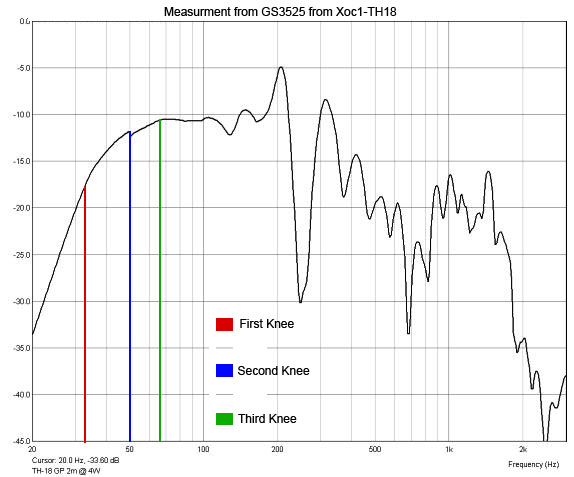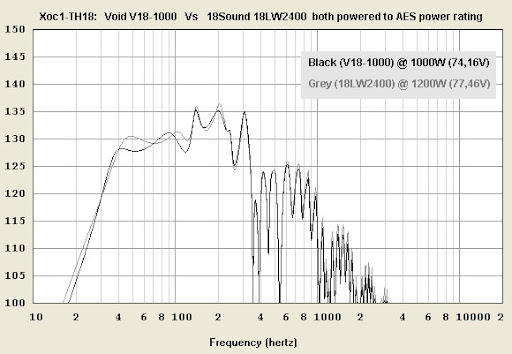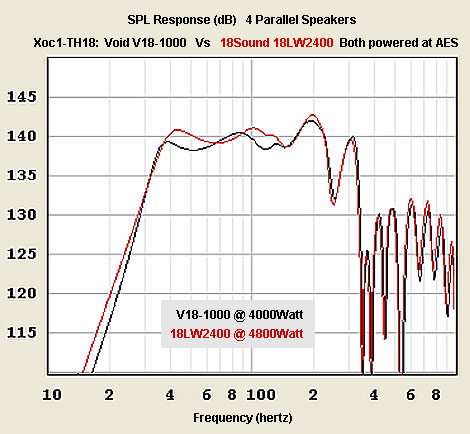I used them once for a boat party and I really enjoyed them. Just haven't had a chance to Use them since.
Mrgsr i remember the first system i had every chance i get i would make some noise with it. My next neighbor use to say bwoy mi can know when you deh home because every ting in a mi house nuh tap vibrate
Last edited:
Pics please.I used them once for a boat party and I really enjoyed them. Just haven't had a chance to
Use them since. So I figure if someone wants them, I'll sell Em (for the right price obviously) I guess I could just use the cash more than the speakers sitting here lol if I do sell I can always build more in the future!!
I just built one, put in a borrowed rcf p300, was supposed to get a tbx100
sounds good, didn't have equipment on hand to crank it up though
just using a lil bash 300w amp and its built in sub xover
Using Room EQ Wizard from the Home theater folks I found that it dips off from 45 down.
Mind you this is in cluttered room.
Anybody did any similar type measurements ?
sounds good, didn't have equipment on hand to crank it up though
just using a lil bash 300w amp and its built in sub xover
Using Room EQ Wizard from the Home theater folks I found that it dips off from 45 down.
Mind you this is in cluttered room.
Anybody did any similar type measurements ?
An externally hosted image should be here but it was not working when we last tested it.
An externally hosted image should be here but it was not working when we last tested it.
I just built one, put in a borrowed rcf p300, was supposed to get a tbx100
sounds good, didn't have equipment on hand to crank it up though
just using a lil bash 300w amp and its built in sub xover
Using Room EQ Wizard from the Home theater folks I found that it dips off from 45 down.
Mind you this is in cluttered room.
Anybody did any similar type measurements ?
Hi LJK11
There are some measurements in post 305
http://www.diyaudio.com/forums/subwoofers/190635-th-18-flat-35hz-xoc1s-design-31.html#post2662947
Some drivers measure lower than others.
I am away from my PC with Hornresp on it at the moment.
The 35Hz Title of this thead refers to groups of 4 cabinets and has not yet been proven!
The intention of this cabinet was for High power & high SPL PA systems.
mRgSr has run his at over 1KW per driver with no problems.
If you can post any measurements please do!
Regards
Martin (Xoc1)
Martin,Hi LJK11
There are some measurements in post 305
http://www.diyaudio.com/forums/subwoofers/190635-th-18-flat-35hz-xoc1s-design-31.html#post2662947
The 35Hz Title of this thead refers to groups of 4 cabinets and has not yet been proven!
Martin (Xoc1)
Tom Danley has stated that multiple TH do not lower the LF corner.
My tests with one and two TH cabinets confirms the low corner does not change, though the upper peaks smooth out a bit.
The LF response shown in post 305 is the response to expect in multiples, of course 2 cabs are +6 dB, and four cabs +12 dB over one cab.
Art Welter
Martin,
Tom Danley has stated that multiple TH do not lower the LF corner.
My tests with one and two TH cabinets confirms the low corner does not change, though the upper peaks smooth out a bit.
The LF response shown in post 305 is the response to expect in multiples, of course 2 cabs are +6 dB, and four cabs +12 dB over one cab.
Art Welter
A 35hz horn with a small mouth and frontal area won't give you a lower corner. But if you design these features in you can move the corner a few hertz when you start building an array.
Your measurments seem to align more or less (roomacoustics?) with the theory and earlier measurements from GS3525.Using Room EQ Wizard from the Home theater folks I found that it dips off from 45 down. Mind you this is in cluttered room.
Theory:
The Xoc1-TH18 pathlength = 345.7cm = 25Hz (1/4WL)
First Knee = 33Hz (1/3WL)
Second Knee = 50Hz (1/2WL)
Third Knee = 66Hz (2/3WL)
Measurement from GS3525:

Void V18-1000 Vs 18LW2400
All sims without power compression:



I find it interesting that some drivers seem to sim with a lower frequency response than others. I am particularly interested in the Void V1000 and PD1850 /1851 that seem to sim slightly lower in frequency and with less efficiency at 1W. I suspect that they make up this loss in efficiency when used at PA levels given that they have low thermal compression due to having 5" voice coils.
If the response does not go lower when the TH cabs are used in multiples, it is unfortunate that Hornresp seems to show an improvement in low frequency extension with multiple cabinets.......
The 35Hz title of this thread seems a little unfortunate given the results .
Never less there is a fine line to be drawn between the limits of size, efficiency, and response. For some this will be the right balance, for others maybe not!
It seems a decent enough PA cab, capable of high power and volume.
Regards
Martin
Hi Martin,
Tapped Horns can gain significantly in LF response from stacking (although different from traditional front loaded horns). When stacked the so called "Knee points" in the response, as given earlier, will become less sharp. Therefore the total performance in LF content will be smoothed out.
Look to a traditional front loaded horn that is designed with a 1/4WL of 30Hz. You need a ridiculous big horn and volume to handle those frequencies. To make the 30Hz horn usable they have to cut the horn mouth considerably which introduces peaks at the corresponding frequency points. Actually in practice it means you need stacks of 6 to 8 of such cabs to make it playable to its lowest point (which is still -6dB from its full WL point).
But with TH’s the trick is to design them with a lower 1/4WL in order to make them play decent in the higher regions. I prefer to see the 1/3WL of TH’s as their low limit (and this point often correspondents to its Max excursion point with a 24dB low cut filter). This point can be lowered trough acoustic coupling but who cares.
However, by acoustic coupling of several TH’s the difference in Decibels between all knee points point below it’s full wavelength will become lower or in other words, a more smooth response!
Roughly said, one optimised TH plays its -3dB at 1/2WL and about -9dB at its 1/3WL, both compared to its full WL point. If you stack 4 of them the 1/2WL is about -0dB and its 1/3WL is at -6dB. So that means its -3dB did shift lower down without changing total WL of the TH as a result of acoustic coupling.
However, doubling this stack from 4 to 8 units will not result in a similar drop of its -3dB point. I haven’t actually tried but my guess is that after stacking 12 units the -3dB point wont change at all any longer.
Although these numbers do not compare to stacking of traditional FLH there is another benefit which is very interesting. At full power all TH's seem to suffer from, what I call, "System Compression". When you start to stack TH's this "system compression" seem to become less.
Anyway, what I'm trying to say here is that stacking TH's do improve their response at LF. It only works differently from FLH. All in all, I still think your Xoc1-TH18 is a marvellous concept that does perform exactly as predicted ! In other words this is where theory is translated one on one to practice. How much more you can ask from a design?
! In other words this is where theory is translated one on one to practice. How much more you can ask from a design?
About the differences between drivers, yes, it is true that some drivers do perform a little different and when they give a little extension in LF content it will automatically mean they ‘suffer’ elsewhere (often total SPL). In case of the PD1850 it can make up against most traditional drivers as power compression is quiet low. However, don’t aspect magic as these drivers do lean on older design principles. 5inch VC’s are becoming quiet normal and the PD suffer from a limited peak power capability. As soon this limit is reached they will burn out more quickly than these new designs from B&C, 18Sound and others.
The so called crest factor is quiet amazing from the latest generation drivers and allow them to be fed way above their continues power when it comes to peaks. In other words the latest generation extended LF drivers are able to play with better dynamics (less THD) at high power and therefore give more SPL in dynamic signals like music.
In case you are not satisfied with the results of your own concept, design a new one with its low limit 6Hz lower. It will cost >3dB of totall SPL, but hey all these limitations keep us busy .
.
Tapped Horns can gain significantly in LF response from stacking (although different from traditional front loaded horns). When stacked the so called "Knee points" in the response, as given earlier, will become less sharp. Therefore the total performance in LF content will be smoothed out.
Look to a traditional front loaded horn that is designed with a 1/4WL of 30Hz. You need a ridiculous big horn and volume to handle those frequencies. To make the 30Hz horn usable they have to cut the horn mouth considerably which introduces peaks at the corresponding frequency points. Actually in practice it means you need stacks of 6 to 8 of such cabs to make it playable to its lowest point (which is still -6dB from its full WL point).
But with TH’s the trick is to design them with a lower 1/4WL in order to make them play decent in the higher regions. I prefer to see the 1/3WL of TH’s as their low limit (and this point often correspondents to its Max excursion point with a 24dB low cut filter). This point can be lowered trough acoustic coupling but who cares.
However, by acoustic coupling of several TH’s the difference in Decibels between all knee points point below it’s full wavelength will become lower or in other words, a more smooth response!
Roughly said, one optimised TH plays its -3dB at 1/2WL and about -9dB at its 1/3WL, both compared to its full WL point. If you stack 4 of them the 1/2WL is about -0dB and its 1/3WL is at -6dB. So that means its -3dB did shift lower down without changing total WL of the TH as a result of acoustic coupling.
However, doubling this stack from 4 to 8 units will not result in a similar drop of its -3dB point. I haven’t actually tried but my guess is that after stacking 12 units the -3dB point wont change at all any longer.
Although these numbers do not compare to stacking of traditional FLH there is another benefit which is very interesting. At full power all TH's seem to suffer from, what I call, "System Compression". When you start to stack TH's this "system compression" seem to become less.
Anyway, what I'm trying to say here is that stacking TH's do improve their response at LF. It only works differently from FLH. All in all, I still think your Xoc1-TH18 is a marvellous concept that does perform exactly as predicted
 ! In other words this is where theory is translated one on one to practice. How much more you can ask from a design?
! In other words this is where theory is translated one on one to practice. How much more you can ask from a design?About the differences between drivers, yes, it is true that some drivers do perform a little different and when they give a little extension in LF content it will automatically mean they ‘suffer’ elsewhere (often total SPL). In case of the PD1850 it can make up against most traditional drivers as power compression is quiet low. However, don’t aspect magic as these drivers do lean on older design principles. 5inch VC’s are becoming quiet normal and the PD suffer from a limited peak power capability. As soon this limit is reached they will burn out more quickly than these new designs from B&C, 18Sound and others.
The so called crest factor is quiet amazing from the latest generation drivers and allow them to be fed way above their continues power when it comes to peaks. In other words the latest generation extended LF drivers are able to play with better dynamics (less THD) at high power and therefore give more SPL in dynamic signals like music.
In case you are not satisfied with the results of your own concept, design a new one with its low limit 6Hz lower. It will cost >3dB of totall SPL, but hey all these limitations keep us busy
I did some more playing with REW but the results a little fishy.
There is a huge dip around 38hz when using the measuring function.
Something is obviously very wrong with my newbie usage of REW.
However I when display the spl meter live and manually generate a signal and scroll through frequencies the spl displayed pretty much follows the measurement from
GS3525
I am using the common ratshack meter and used the calibration files for it and calibrated my sound card also.
Will have to play with REW more and also if the cluttered room is causing problems.
I also have a TH-Spud clone I measured as well, its in the corner of one of the pics earlier.
L
There is a huge dip around 38hz when using the measuring function.
Something is obviously very wrong with my newbie usage of REW.
However I when display the spl meter live and manually generate a signal and scroll through frequencies the spl displayed pretty much follows the measurement from
GS3525
I am using the common ratshack meter and used the calibration files for it and calibrated my sound card also.
Will have to play with REW more and also if the cluttered room is causing problems.
I also have a TH-Spud clone I measured as well, its in the corner of one of the pics earlier.
L
An externally hosted image should be here but it was not working when we last tested it.
I put the meter on a tripod and graph is not as jerky but dip is still there.
Ignore the actual db numbers as I did not go about setting levels and mic distance.
Friend who is a real DJ came across and put some stuff through it and was very impressed with the quality of sound from it.
Ignore the actual db numbers as I did not go about setting levels and mic distance.
Friend who is a real DJ came across and put some stuff through it and was very impressed with the quality of sound from it.
An externally hosted image should be here but it was not working when we last tested it.
I did manual spl measurements with REW using the generator to generate a series of frequencies and wrote down the spl meter reading
results are much more realistic and inline with previous measurements of others.
results are much more realistic and inline with previous measurements of others.
An externally hosted image should be here but it was not working when we last tested it.
An externally hosted image should be here but it was not working when we last tested it.
An externally hosted image should be here but it was not working when we last tested it.
An externally hosted image should be here but it was not working when we last tested it.
flipped it over but its not sitting properly as one edge was cut oversized
took a measurement anyway and it was more pronounced,
the dip after 60hz was sharper.
The floor is actually concrete with a vinyl covering,
how can I "float" the mic ?
took a measurement anyway and it was more pronounced,
the dip after 60hz was sharper.
The floor is actually concrete with a vinyl covering,
how can I "float" the mic ?
Ljk, you could try to turn that cab upside down (mouth to the floor) and try measuring it again. Ps also make sure the mic is 'floating' cause your boomstand is standing on a wooden floor....
- Home
- Loudspeakers
- Subwoofers
- TH-18 Flat to 35hz! (Xoc1's design)